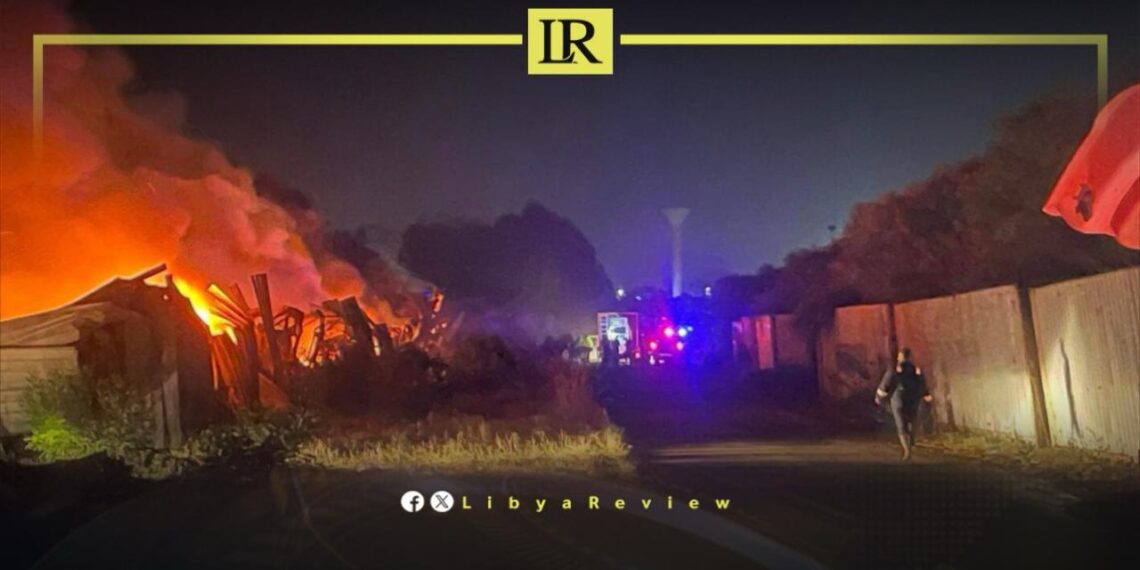The Libyan Atomic Energy Establishment (AEE) has confirmed that no damage occurred as a result of a fire at the Tajoura nuclear power centre. It stated on Monday that the fire broke out in an old hangar within the centre and has been fully extinguished.
The agency explained that “the fire broke out on Sunday evening in one of the old hangars at the nuclear research centre… It has been fully extinguished,… and it was far from any vital buildings within the centre.”
The Emergency and Ambulance Services published photos of the fire scenes in the hangar, praising the efforts of their teams in supporting and assisting the civil defence teams in containing the fire.
The National Safety Authority also confirmed that the firefighting teams have completely extinguished the fire. The authority stated that the fire was bravely and professionally contained.
In March 2023, Libyan experts expressed concerns about the presence of uranium in Libya, calling on the International Atomic Energy Agency (IAEA) to transport them out of the war-torn country.
According to the UAE newspaper, Al-Ittihad, Libyan political analyst Haitham Ahmed Al-Werfalli expressed concern about the involvement of “mysterious parties” in the attempt to seize 2.5 tons of uranium in Libya.
“If that quantity is sold, the price will not be high, but the risks are much greater. My country does not want this substance on its territory,” Al-Werfalli said.
He blamed the IAEA for “failing to protect and guard those dangerous radioactive materials.”
“Transporting uranium from a place without specialists poses a danger to Libyans from the emissions that cause many diseases, such as cancer,” he explained.
Moreover, Libyan affairs researcher, Mohamed Hamida expressed his fear that a terrorist group might be behind the disappearance of the uranium barrels. This is to try and use them in the manufacture of explosives or the development of dangerous weapons.
On Saturday, the IAEA told member states that most of the 2.5 tons of natural uranium ore concentrate (UOC) recently declared missing in Libya has been found, according to a statement seen by Reuters.m
The UN’s nuclear watchdog informed member states in a similar confidential statement on 15 March, that 10 drums containing UOC had gone missing from a Libyan site not under government control.
The amount of fissile material is less than that required for a nuclear bomb, and would need to go through processes known as conversion, and enrichment to be usable. The IAEA said at the time that losing it “may present a radiological risk, as well as nuclear security concerns.”
Following statements last year by eastern Libyan forces’ that they had found the UOC drums near a warehouse in southern Libya, the IAEA carried out an inspection. It found that only “a relatively small amount of UOC was still unaccounted for,” the statement noted.
“Agency inspectors observed that drums that had not been present at the declared location at the time of the previous (inspection) had since been brought back, and left in close proximity to the declared location,” it said.
“Agency inspectors confirmed that these drums contained UOC, and witnessed their transfer back to within the declared location for storage,” the statement added.
Under the rule of late longtime leader Muammar Gaddafi, Libya had stored thousands of barrels of so-called yellowcake uranium. This was for a once-planned conversion facility that was never built in his decades-long secret weapons program, according to the Daily Mail.
Estimates put the Libyan stockpile at 1,000 metric tons. Gaddafi declared his nascent nuclear weapons program to the world in 2003, after the US-led invasion of Iraq.
While inspectors removed the last of the enriched uranium from Libya in 2009, the yellowcake remained behind. In 2013, the UN estimated that 6,400 barrels were stored in Sebha.


